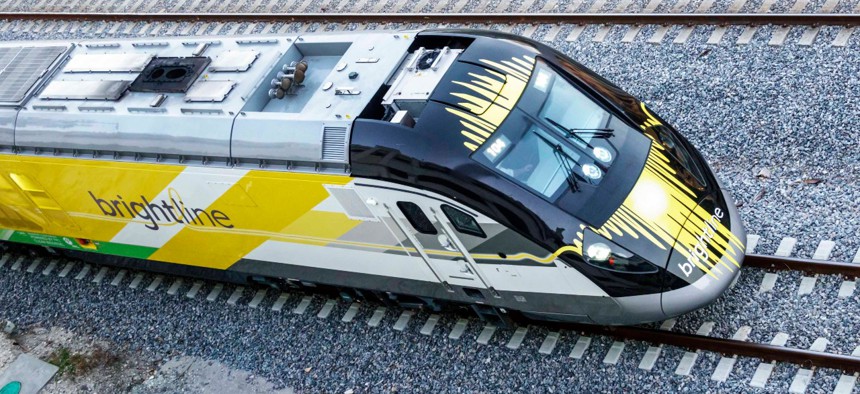Can the future of passenger rail be found between Miami and Orlando?

Brightline, which currently runs passenger rail between Miami and West Palm Beach, is set to open its expanded service on September 22. Jeffrey Greenberg/Universal Images Group via Getty Images
The debut of Brightline service linking Miami to the central Florida tourist mecca is giving rail advocates hope that passenger rail will gain popularity elsewhere, too.
A private railroad operator will start service between Orlando and Miami next week, with trains reaching 125 miles an hour on the three-hour journey. It marks the first time in decades that American cities will get a new rapid rail connection, and it will offer the fastest trains outside of the Northeast Corridor.
Brightline, the company that operates the trains, said service between Orlando’s airport and downtown Miami will start Friday, Sept. 22. The railroad started service between Miami and West Palm Beach in 2018, but the new 235-mile route will take its trains further up the coast to Cocoa (near Cape Canaveral) and then northwest alongside a highway until reaching the Orlando airport. Eventually, Brightline hopes to connect the line to the Tampa area on the Gulf Coast as well.
“Opening Orlando fulfills our ultimate business model,” said Patrick Goddard, president of Brightline, in a statement. “We have seen incredible enthusiasm from the business and tourism industries eager to travel between Central and South Florida.”
The project has drawn a lot of interest from rail advocates, especially as the Biden administration is in the process of rolling out a major expansion of passenger rail service with money from the 2021 infrastructure bill. Most of those proposals, though, depend on a half-century-old model for operating passenger rail in the U.S.: Amtrak, a government-funded company, runs a few trains a day between cities on tracks that are owned and operated by freight rail carriers.
But Brightline is a private company that essentially owns and manages its own tracks, and it has made major upgrades to prioritize passenger trains.
“Americans from all across the country will be flying to Orlando and have the opportunity to take the train—a modern train—to Miami,” said Rick Harnish, the executive director of the High Speed Rail Alliance. “They’ll see what American trains can be, and hopefully start telling their congressman they want them back home, too.”
Harnish said Brightline’s ambitions also set it apart from most of the Amtrak network. Amtrak, he says, is essentially two different systems. One is in the Northeast Corridor, between Boston and Washington, D.C., where Amtrak owns the tracks and offers frequent service. The other system operates everywhere else in the country, where service is infrequent and runs on tracks owned by freight carriers. Many states pay Amtrak to run shorter-distance trains, but even those run only a few times a day.
“Across the country, there are proposals for starting new passenger routes. And the states are proposing like one or two trains a day—maybe three or four,” Harnish said. “You can’t compete with the automobile if you only have one or two trains a day.”
Advocates of that approach say they just want to see if the service will succeed. But Harnish said that they are actually guaranteeing that it’ll fail. “All kinds of proposals out there that are driven by states are essentially setting themselves up for failure because they’re not frequent,” he said. “And Brightline has walked in and said, ‘We are launching with hourly service.’”
Harnish said Brightline’s model might not work in many other places in the U.S. In Florida, the company that launched Brightline built the railroad along the Atlantic coast more than a century ago. It also owns real estate along the corridor, particularly near its stations, that has been developed alongside the new rail service. That’s another source of revenue for the company, besides just fares.
Although Brightline is a private company, it has used public financing and other government-funded infrastructure for its Florida route and plans to do the same for high-speed rail service it would like to build between Las Vegas and suburban Los Angeles. In that way, Harnish said, Brightline is like almost any other kind of transportation infrastructure, from highways to airports.
The success of a Las Vegas and suburban Los Angeles route depends on the unique travel patterns of the Las Vegas area, especially the stream of people coming from Southern California to gamble or get married in the desert mecca. In fact, the original plan for connecting the two cities via rail was developed by a casino owner, Harnish pointed out. (Two of the top destinations for discount airlines, incidentally, are Orlando and Las Vegas.)
While Brightline’s model may not be feasible for everyone, states can learn from the preparation that Florida made to clear the way for high-speed rail decades ago, according to Harnish. The state began work on establishing a passenger rail network in the 1990s. Because that plan was in place, there was a mechanism for building the rail station at the Orlando airport and there was a way to secure the right-of-way for the new track to be built, he said.
“It is essential that states have a high speed rail plan and that they are engaged—at a minimum—and assemble it iteratively,” he said.
Daniel C. Vock is a senior reporter for Route Fifty based in Washington, D.C.
NEXT STORY: Transportation is feeling the heat






